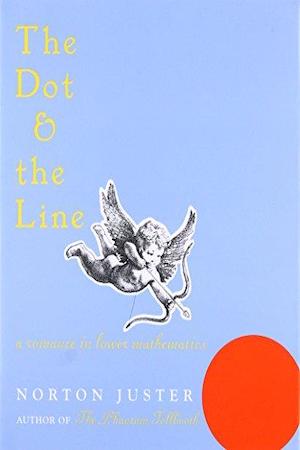
Summary:
Once upon a time there was a sensible straight line who was hopelessly in love with a beautiful dot. But the dot, though perfect in every way, only had eyes for a wild and unkempt squiggle. All of the line’s romantic dreams were in vain, until he discovered…angles! Now, with newfound self-expression, he can be anything he wants to be–a square, a triangle, a parallelogram….And that’s just the beginning!First published in 1963 and made into an Academy Award-winning animated short film, here is a supremely witty love story with a twist that reveals profound truths about relationships–both human and mathematical–sure to tickle lovers of all ages.
Publication Date: 1963
Category: category-defying math parable; romance
ScienceThrillers technical content rating: ![]()
ScienceThrillers.com book review of The Dot and the Line :
Math with a moral!
I discovered the most delightful, unexpected little book which you, my intellectually gifted readers, might enjoy. The Dot and the Line, a Romance in Lower Mathematics looks like a picture book one might read to a toddler at bedtime. Written by Norton Juster, the master of wordplay who wrote the children’s classic The Phantom Tollbooth, this diminutive volume is much more. Imagine this: a charming morality tale using geometry to illustrate character–told as a love story between a stiff, boring line and a frivolous, perfect circle.
Here’s the central conflict: the dull, conventional line is deeply in love with the circle, but she isn’t interested in him. Rather, she is attracted to the squiggle, who is depicted as a disorderly mess. In the beginning, she perceives the squiggle as “gay and free, so uninhibited and full of joy.” A hilarious sequence of pages in the middle of the book depict the line fantasizing about himself as various types of hero to woo the circle, including “The Line as a Leader in World Affairs” (drawn as the Equator), and more.
But rather than mope in wishfulness, the line seeks to improve himself. “With great concentration and self-control” he learns how to make an angle, and he is forever changed. “For months, he practiced in secret. Soon he was making squares and triangles, hexagons, parallelograms, rhomboids, polyhedrons…”
With discipline and practice, the line learns to express his creativity with a depth and complexity that the sloppy, random squiggle cannot match. Our hero gets the girl, who utters my favorite line in the book.
“What she had thought was freedom and joy
was nothing but anarchy and sloth.”
I read The Dot and the Line to my 9- and 10-year-old kids. They loved the well-chosen words and clever illustrations. Maybe one day as they struggle with the rigors of Bach in their music practice, they’ll see the parallels between their own performance and the line’s, against their peers’ Rock Band gyrations and the squiggle.
The Dot and the Line was made into a ten minute animated film which won an Academy Award in 1965. You can view the film here.
Based on 2001 hardcover edition by Chronicle Books.




0 Comments